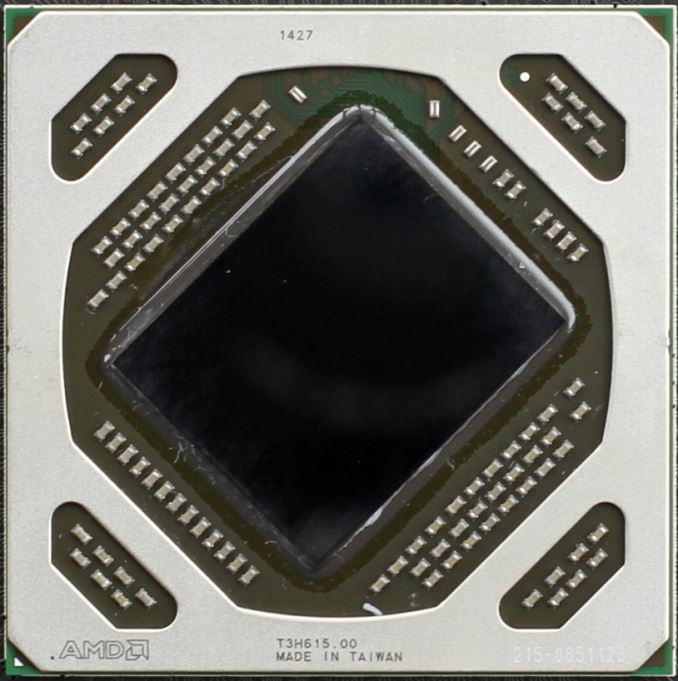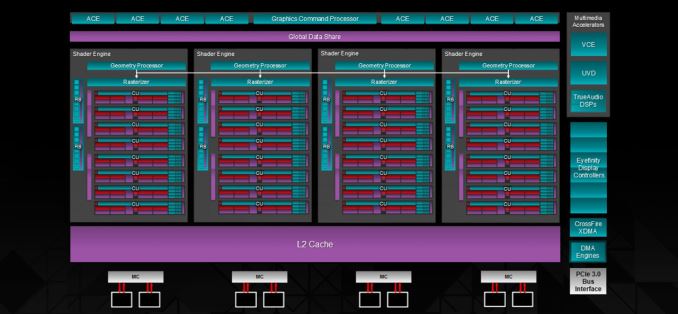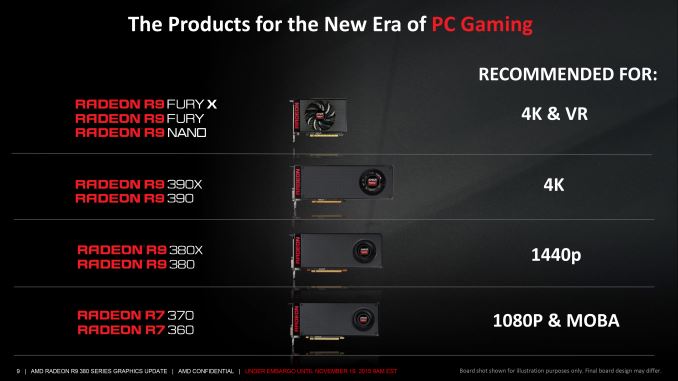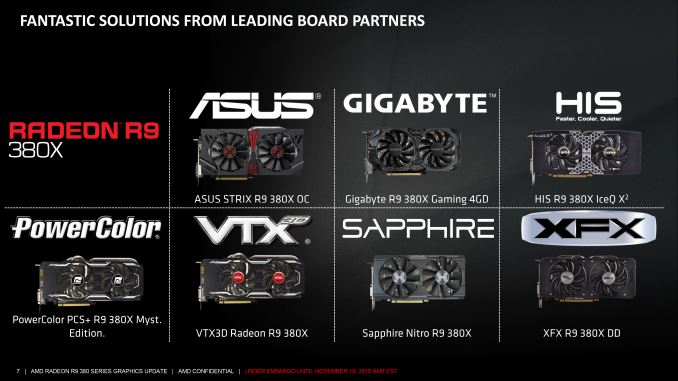AMD Launches Radeon R9 380X: Full-Featured Tonga at $229 for the Holidays
by Ryan Smith on November 19, 2015 9:01 AM EST- Posted in
- GPUs
- AMD
- Radeon
- Radeon 300

Back in September of 2014 AMD released their first Graphics Core Next 1.2 GPU, Tonga, which was the GPU at the heart of the Radeon R9 285. For all intents and purposes Tonga was the modern successor to AMD’s original GCN GPU, Tahiti, packing in the same 32 CUs and 32 ROPs, while other features such as color compression allowed AMD to trim the memory bus to 256-bits wide without a performance hit. With Tahiti slowly going out of date from a feature perspective, Tonga was an interesting and unprecedented mid-cycle refresh of a GPU.
However in the 14 months since the launch of the first Tonga product AMD has never released a fully enabled desktop SKU, until now. Radeon R9 285 utilized a partially disabled Tonga – only 28 of 32 CUs were enabled – and while it was refreshed as the Radeon R9 380 as part of the Radeon 300 series launch, a fully enabled version of Tonga only showed up in mobile, where in the form of the R9 M295X it was used in the 27” iMac. In its place AMD continued selling the Tahiti based Radeon R9 280 series for much longer than we would have expected, leading to an atypical situation for AMD where a card using the fully enabled GPU is only now showing up over a year later. In some ways Radeon R9 380X is a card we were starting to think we’d never see.
But at last a full-featured Tonga is here as the heart of AMD’s latest video card, the Radeon R9 380X. AMD is launching the 380X at this time to setup their product stack for the holidays, looking to shake up the market shortly before Black Friday and dig out a spot in the gap between NVIDIA’s GeForce GTX 970 and GTX 960 cards. By hitting NVIDIA a bit above the ever-popular $200 spot, AMD is aiming to edge out NVIDIA on price/performance while also snagging gamers looking to upgrade from circa 2012 video cards.
| AMD GPU Specification Comparison | ||||||
| AMD Radeon R9 390 | AMD Radeon R9 380X | AMD Radeon R9 380 | AMD Radeon 280X | |||
| Stream Processors | 2560 | 2048 | 1792 | 2048 | ||
| Texture Units | 160 | 128 | 112 | 128 | ||
| ROPs | 64 | 32 | 32 | 32 | ||
| Boost Clock | 1000MHz | 970MHz | 970MHz | 1000MHz | ||
| Memory Clock | 6Gbps GDDR5 | 5.7Gbps GDDR5 | 5.5Gbps GDDR5 | 6Gbps GDDR5 | ||
| Memory Bus Width | 512-bit | 256-bit | 256-bit | 384-bit | ||
| VRAM | 8GB | 4GB | 2GB | 3GB | ||
| FP64 | 1/8 | 1/16 | 1/16 | 1/4 | ||
| TrueAudio | Y | Y | Y | N | ||
| Transistor Count | 6.2B | 5.0B | 5.0B | 4.31B | ||
| Typical Board Power | 275W | 190W | 190W | 250W | ||
| Manufacturing Process | TSMC 28nm | TSMC 28nm | TSMC 28nm | TSMC 28nm | ||
| Architecture | GCN 1.1 | GCN 1.2 | GCN 1.2 | GCN 1.0 | ||
| GPU | Hawaii | Tonga | Tonga | Tahiti | ||
| Launch Date | 06/18/15 | 11/19/15 | 06/18/15 | 10/11/13 | ||
| Launch Price | $329 | $229 | $199 | $299 | ||
Starting as always from a specification comparison, the R9 380X is going to be a very straightforward card. Rather than R9 380’s 28 CUs, all 32 CUs are enabled for R9 380X. As this was the only thing disabled on R9 380, this means that the increased stream processors and texture resources are the only material GPU change as opposed to the R9 380. Otherwise we’re still looking at the same 32 ROPs backed by a 256-bit memory bus, all clocked at 970MHz.
Meanwhile as far as memory goes, the R9 380X sees AMD raise the default memory configuration from 2GB for the R9 380 to 4GB for this card. We’ve reached the point where 2GB cards are struggling even at 1080p – thanks in large part to the consoles and their 8GB of shared memory – so to see 4GB as the base configuration is a welcome change. R9 380 did offer both 2GB and 4GB, but as one might expect, 2GB was (and still is) the more common SKU that for better or worse makes R9 380X stand apart from its older sibling even more. Otherwise the 5.7Gbps memory clockspeed of the R9 380X is a slight bump from 5.5Gbps of the 2GB R9 380, though it should be noted that 5.7Gbps was also the minimum for the 4GB R9 380 SKUs. So in practice just as how there’s no increase in the GPU clockspeed, there’s no increase in the memory clockspeed (or bandwidth) with 4GB cards.
Similarly, from a power perspective the R9 380X’s typical board power remains unchanged at 190W. In practice it will be slightly higher thanks to the enabled CUs, but otherwise AMD hasn’t made any significant changes to shift it one way or another.
From a performance perspective then the R9 380X is not going to be a very exciting card. After 3 releases of the fully enabled Tahiti GPU – Radeon 7970, 7970 GHz Edition, and R9 280X – the architectural and clockspeed similarities of R9 380X mean that it’s essentially a fourth revision of this product. Which is to say that you’re looking at performance a percent or two better than the 7970, well-tread territory at this point.
The R9 380X’s principle reason to exist at this point is to allow AMD to refresh their lineup by tapping the rest of Tonga’s GPU performance, both to have something new to close out the rest of the year and to give them a card that can sit solidly between NVIDIA’s GeForce GTX 970 and GTX 960. That AMD is launching it now is somewhat arbitrary – we haven’t seen anything new in the $200 to $500 range since the GTX 960 launched in January and AMD could have launched it at any time since – and along those lines AMD tells us that they haven’t seen a need to launch this part until now. With the R9 380 otherwise shoring up the $199 price point until more recently, there’s always a trade-off to be had with having better positioning than the competition versus having too many products in your line (with the 300 + Fury series the tally is now 9 cards).
In AMD’s new lineup the R9 380X will slot in between AMD’s more expensive R9 390 and the cheaper R9 380. AMD is promoting this card as an entry-level card for 2560x1440 gaming, though with the more strenuous games released in the last 6 months that is going to require some quality compromises to achieve. As it stands I’d consider the 390 more of a 1440p card, while the R9 380X is better positioned as AMD’s strongest 1080p card; only in the most demanding games should the R9 380X face any real challenge.
| AMD Relative Benchmark Performance (1080p) | |||||
| Card | Performance | Price | |||
| Radeon R9 390 | 157% | $289 | |||
| Radeon R9 380X | 110% | $229 | |||
| Radeon R9 380 (2GB) | 100% | $179 | |||
| Radeon R9 370 | 78% | $129 | |||
| Radeon HD 7850 | 63% | N/A | |||
As far as performance goes then, the R9 380X is about 10% faster than the 2GB R9 380 at 1080p, with the card taking a much more significant advantage in games where 2GB cards are memory bottlenecked. Otherwise the performance is almost exactly on-par with the 7970 and its variants, while the more powerful R9 390 has a sizable 43% performance advantage thanks to its greater CU count, memory bandwidth, and ROPs. This makes the R9 390 a bit of a spoiler on value, though its $290+ price tag ultimately puts it in its own class. Or to throw in a quick generational comparsion to AMD's original $250 GCN card, Radoen HD 7850, you're looking at a 75% increase in performance at this price bracket over 3 years.
Today’s launch of the R9 380X is a hard launch, with multiple board partners launching cards today. For most of the partners they will be reusing their R9 380 designs, which is fitting given the similarities between the two cards. Expect to see a significant number of factory overclocked cards, as Tonga has some headroom for the partners to play with. OC cards will start at $239 – a $10 premium – while the card we’ve been sampled from AMD, ASUS’s STRIX R9 380X OC, will retail for $259.
As for the competition, as I previously mentioned AMD will be slotting in between the GeForce GTX 970 and GTX 960. The former is going to be quite a bit faster but also quite a bit more expensive, while the R9 380X will handily best the 2GB GTX 960, albeit with a price premium of its own. At this point it’s safe to say that AMD holds a distinct edge on performance for the price, as they often do, though as has been the case all this generation they aren’t going to match NVIDIA’s power efficiency.
Finally, on a housekeeping note we’ll be back on Monday with a review of the ASUS STRIX R9 380X alongside a look at performance at reference clocks. We’ve only had the card and AMD’s launch drivers since the beginning of this week and there is still some work to be done before we can publish our review, so stay tuned.
| Fall/Winter 2015 GPU Pricing Comparison | |||||
| AMD | Price | NVIDIA | |||
| Radeon R9 Fury | $529 | ||||
| $469 | GeForce GTX 980 | ||||
| Radeon R9 390X | $379 | ||||
| Radeon R9 390 | $289 | GeForce GTX 970 | |||
| Radeon R9 380X | $229 | ||||
| Radeon R9 380 | $179/$169 | GeForce GTX 960 | |||
| $149 | GeForce GTX 950 | ||||
| Radeon R9 370 | $129 | ||||














52 Comments
View All Comments
cygnus1 - Thursday, November 19, 2015 - link
Or because you're selling every single one to Apple...AS118 - Thursday, November 19, 2015 - link
That's probably about the size of it. They do have to give the best ones to Apple.ImSpartacus - Thursday, November 19, 2015 - link
Nah, it wasn't yields - not on that mature process.It's a combination of two factors.
The first is that Apple bought a lot of them. If you have the option to sell a chip to Apple, you better sell it to Apple.
The second was the 290 dropping in price so much meant that there was simply no room for a fully enabled Tonga part. It would either have to be stupidly cheap or else everyone would just get a 290.
And why would you sell your chips cheaply when Apple is willing to buy?
But now the 290 is falling out of style and there's now room for a profitably priced fully enabled Tonga.
SunnyNW - Sunday, November 22, 2015 - link
I disagree with it having anything to do with Apple. Everyone seems to agree that yields are Very high (for 28nm) so AMD was paying for a die size with 32 CU (compute units) but only enabling 28 of them and selling the chips as R9 285s and R9 380s. So obviously they were paying for a large die but than cutting it down for lower performance. Now I am not saying I know as to why they did this, they must have Some kind of business reasoning behind it, but I do not think Apple had anything to do with it.MrSpadge - Thursday, November 19, 2015 - link
"... they haven’t seen a need to launch this part until"Exactly. Better sell those chips for significantly less money in cut-down versions and don't tempt any customers with offers too good. That would put the current average selling price and market share numbers at risk.
SunnyNW - Sunday, November 22, 2015 - link
LOL. Exactly^zeeBomb - Thursday, November 19, 2015 - link
R9 my body can't handle 380X.calculagator - Thursday, November 19, 2015 - link
I'm definitely interested in how this card stacks up. The 7970 has been my go-to AMD card for quite a while; it is nice to have a potential successor with better performance and lower power usage.I am also very interested to see if the release of the fully enabled Tonga could open the door to unlocking the partially disabled 285 and 380.
The_Assimilator - Thursday, November 19, 2015 - link
"... the architectural and clockspeed similarities of R9 380X mean that it’s essentially a fourth revision of this product. Which is to say that you’re looking at performance a percent or two better than the 7970, well-tread territory at this point."Don't waste your money, wait for Pascal and Arctic Islands.
calculagator - Thursday, November 19, 2015 - link
Looking at the benchmarks just added to the comparison tool, I have to agree with you. From the description, I thought it would regularly beat the 7970 (if only by a small margin) and use quite a bit less power. While it does use maybe 20w less under load, it doesn't have any clear advantage over the 7970-it actually has slightly worse performance in quite a few tests.Really the lack of performance vs the 7970 is the least of its problems right now since you can get either an R9 290 or GTX 970 for pretty much the same price or less, both of which thoroughly trounce the 380X.